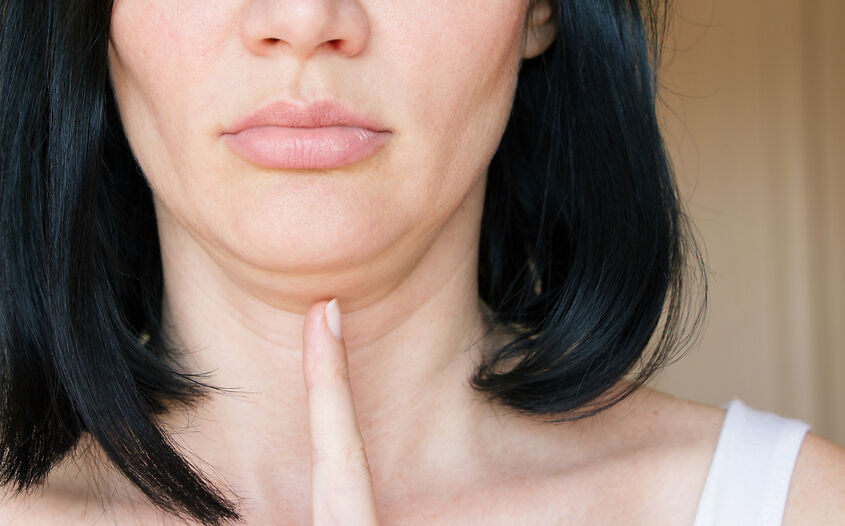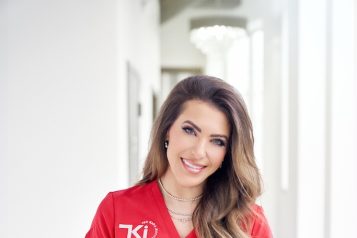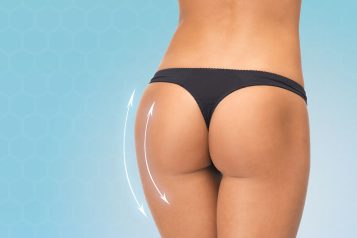 Photo Credit: Courtesy of Geinz Angelina/Shutterstock
Photo Credit: Courtesy of Geinz Angelina/Shutterstock
Kirsten A. Schuster, MD, JD; Iulianna C. Taritsa, BA; Samuel J. Lin, MD, FACS
Whether the result of an unflattering selfie angle or a permanent protrusion, almost 75 percent of us report being bothered by the appearance of a double chin (Baumann et al., 2019). While exacerbated by weight gain, a double chin is often the result of both lifestyle factors and genetics (Baumann et al., 2019). In addition to excess fat and skin, several elements that may contribute to the unsightly submental (under-chin) bulge include fluid buildup, a relatively small chin, neck muscle laxity, enlarged glands, and prominent jaw muscles (Marten & Elyassnia, 2018). As a result, which treatment plan will work best for you depends on the actual cause of the problem.
Effective Exercises and Tips for a Toned Neck and Jawline
While fat deposition in the area may require weight loss or more invasive treatments, sometimes excess fluid buildup under the chin can be alleviated by certain exercises that work to drain lymph that stagnates in the area.
One exercise to help drain lymph is to massage the area under the chin and around the neck with upward motions with the index and middle finger, starting at the base of the neck and moving up under the chin. Massaging for several minutes may help reduce the appearance of a double chin. Slow neck rolls or rotating the head in slow circles may have a similar effect. Some have suggested that tongue exercises (e.g., sticking out the tongue in an upward and outwards direction) can help decrease the appearance of a double chin as well. Exercising regularly, drinking plenty of water, and avoiding alcohol are all ways to generally keep fluid buildup minimal. Regular exercise may also help with weight loss and general skin tightening which can help decrease a stubborn double chin. More invasive options may be necessary if these options are insufficient.
From Natural Approaches to Advanced Techniques
For the treatment of a double chin, the most natural and less invasive option is weight loss through diet and exercise. Losing weight can reduce the burden of fat deposited under the chin and help decrease rolls of skin in the area as well. Massage tools and serums enriched with collagen or caffeine may help stimulate collagen production in the area to help the skin resist the weight of the fat in the area. Lipolysis is an option that individuals may seek out if more natural options are not enough to reduce the appearance of their double chin. Lipolysis can occur through the injection of a fat-dissolving solution into the chin area or using a laser. Injection lipolysis requires multiple rounds of injections for four to six weeks. Laser lipolysis is less invasive. Both lipolysis techniques may be associated with mild swelling, burning, or bruising afterwards, but are generally well tolerated.
Mesotherapy, with the agent most used being Kybella (deoxycholic acid), is similar to injection lipolysis and can be used to dissolve fat under the chin (Shamban, 2016). Mesotherapy differs from traditional injection lipolysis in that it targets fat cells in the layer of skin known as the mesoderm, rather than the subcutaneous fat. It may take up to 20 injections with Kybella to see results, with up to six treatments in total and one month between treatments. Speak to your dermatologist or plastic surgeon for consultation if you wish to pursue mesotherapy. Nerve damage is possible if incorrectly injected, and less severe but more common side effects include swelling, bruising, pain, numbness, and redness in the injection site.
Finally, some patients pursue Coolsculpting, a technique that freezes fat cells rather than dissolves them. The body eliminates the dead fat cells over time, thus it may take longer to see definite results. Patients should expect to see the full effect of this procedure after two months.
Exploring Surgical Options for Resilient Double Chins
For double chins resistant to less invasive treatments, surgery may be an option. Several procedures, each with increasing levels of invasiveness, include liposuction, “short scar” neck lift (submentoplasty), chin augmentation (genioplasty) or implant, extended neck lift with or without a facelift, and reduction of enlarged glands or muscles. Which procedure may be indicated depends on the underlying cause of the double chin and several other factors including age, amount and location of excess skin and fat, laxity or banding of the superficial neck muscle (platysma), bone structure, and any previous procedures you may have had done in the area (Baumann et al, 2019). Consult with your board-certified plastic surgeon to discuss your goals and see which of these options may be right for you.
For those who are worried about the appearance of their double chin, luckily there are many natural ways to reduce their appearance. Weight loss through diet and exercise can help decrease area fat and improve health overall. Staying consistent with healthy routines can be rewarding over time as chin fat disappears, and overall satisfaction and self-confidence improve.
References
Baumann L, Shridharani SM, Humphrey S, & Gallagher, CJ. Personal (Self) Perceptions of Submental Fat Among Adults in the United States. Dermatologic Surgery. 2019;45(1):124–130. https://doi.org/10.1097/DSS.0000000000001648
Marten T & Elyassnia D. Neck Lift. Clinics in Plast Surg. 2018;45(4):455-84.
Shamban AT. Noninvasive Submental Fat Compartment Treatment. Plast Reconstr Surg Glob Open. 2016 Dec 14;4(12 Suppl Anatomy and Safety in Cosmetic Medicine: Cosmetic Bootcamp):e1155. doi: 10.1097/GOX.0000000000001155. PMID: 28018773; PMCID: PMC5172481.
For more information, visit Dr. Brian A. Levine's social media:

























